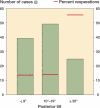A new measurement for posterior tilt predicts reoperation in undisplaced femoral neck fractures: 113 consecutive patients treated by internal fixation and followed for 1 year
- PMID: 19634021
- PMCID: PMC2823202
- DOI: 10.3109/17453670902967281
A new measurement for posterior tilt predicts reoperation in undisplaced femoral neck fractures: 113 consecutive patients treated by internal fixation and followed for 1 year
Abstract
Background and purpose: Preoperative posterior tilt in undisplaced (Garden I-II) femoral neck fractures is thought to influence rates of reoperation. However, an exact method for its measurement has not yet been presented. We designed a new measurement for posterior tilt on preoperative lateral radiographs and investigated its association with later reoperation.
Patients and methods: A consecutive series of 113 patients, > or = 60 years of age with undisplaced (Garden I-II) femoral neck fractures treated with two parallel implants, was assessed regarding patient characteristics, radiographs, and rate of reoperation within the first year. In a subgroup of 50 randomly selected patients, reliability tests for measurement of posterior tilt were performed.
Results: Intra- and interclass coefficients for the new measurement were > or = 0.94. 23% (26/113) of patients were reoperated and increased posterior tilt was an accurate predictor of failure (p = 0.002). 14/25 of posteriorly tilted fractures > or = 20 degrees were reoperated, as compared to 12/88 of fractures with less tilt (p < 0.001). In multiple logistic regression analysis including sex, age, ASA score, cognitive function, new mobility score, time from admission to operation, surgeon's expertise, postoperative reduction, and implant positioning, a preoperative posterior tilt of > or = 20 degrees was the only significant predictor of reoperation (p < 0.001).
Interpretation: The new measurement for posterior tilt appears to be reliable and able to predict reoperation in patients with undisplaced (Garden I-II) femoral neck fractures.
Figures


Comment in
-
Preoperative posterior tilt of at least 20° increased the risk of fixation failure in Garden-I and -II femoral neck fractures.Acta Orthop. 2016 Jun;87(3):252-6. doi: 10.3109/17453674.2016.1155253. Epub 2016 Mar 3. Acta Orthop. 2016. PMID: 26937557 Free PMC article.
Similar articles
-
Internal fixation of garden I and II femoral neck fractures: posterior tilt did not influence the reoperation rate in 382 consecutive hips followed for a minimum of 5 years.J Orthop Trauma. 2013 Jul;27(7):386-90; discussion 390-1. doi: 10.1097/BOT.0b013e318281da6e. J Orthop Trauma. 2013. PMID: 23287762
-
Posterior and anterior tilt increases the risk of failure after internal fixation of Garden I and II femoral neck fracture.Acta Orthop. 2019 Dec;90(6):537-541. doi: 10.1080/17453674.2019.1637469. Epub 2019 Jul 4. Acta Orthop. 2019. PMID: 31269853 Free PMC article.
-
Not All Garden-I and II Femoral Neck Fractures in the Elderly Should Be Fixed: Effect of Posterior Tilt on Rates of Subsequent Arthroplasty.J Bone Joint Surg Am. 2019 Oct 16;101(20):1852-1859. doi: 10.2106/JBJS.18.01256. J Bone Joint Surg Am. 2019. PMID: 31626010 Free PMC article. Clinical Trial.
-
Role of preoperative posterior tilt on the outcomes of internal fixation of non-displaced femoral neck fractures: A systematic review and meta-analysis.Injury. 2021 Mar;52(3):316-323. doi: 10.1016/j.injury.2020.11.063. Epub 2020 Nov 23. Injury. 2021. PMID: 33257020
-
Evaluation of the Posterior Tilt Angle in Predicting Failure of Nondisplaced Femoral Neck Fractures After Internal Fixation: A Systematic Review.J Orthop Trauma. 2023 Feb 1;37(2):e89-e94. doi: 10.1097/BOT.0000000000002490. J Orthop Trauma. 2023. PMID: 36150078
Cited by
-
Development and validation of a predictive nomogram for postoperative osteonecrosis of the femoral head with cannulated screws fixation.Ann Transl Med. 2021 Feb;9(4):281. doi: 10.21037/atm-20-4866. Ann Transl Med. 2021. PMID: 33708908 Free PMC article.
-
Postoperative Valgus Deformity and Progression of Ostheoarthritis in Non-Displaced Femoral Neck Fractures.Hip Pelvis. 2023 Dec;35(4):259-267. doi: 10.5371/hp.2023.35.4.259. Epub 2023 Dec 4. Hip Pelvis. 2023. PMID: 38125270 Free PMC article.
-
Improved outcome after hip fracture surgery in Norway.Acta Orthop. 2017 Oct;88(5):505-511. doi: 10.1080/17453674.2017.1344456. Epub 2017 Jul 6. Acta Orthop. 2017. PMID: 28681677 Free PMC article.
-
Comparable results for the Femoral Neck System and three-screw fixation in femoral neck fracture treatment.OTA Int. 2024 Dec 27;8(1):e351. doi: 10.1097/OI9.0000000000000351. eCollection 2025 Mar. OTA Int. 2024. PMID: 39737137 Free PMC article.
-
"In-Out-In" Percutaneous Reduction Technique for Treatment of Valgus-Impacted Femoral Neck Fractures: A Technical Trick and Case Series.Orthop Surg. 2023 Jan;15(1):214-222. doi: 10.1111/os.13582. Epub 2022 Nov 23. Orthop Surg. 2023. PMID: 36419316 Free PMC article.
References
-
- Alho A, Benterud JG, Ronningen H, Hoiseth A. Radiographic prediction of early failure in femoral neck fracture. Acta Orthop Scand. 1991;62:422–6. - PubMed
-
- Alho A, Benterud JG, Ronningen H, Hoiseth A. Predicture of disturbed healing in femoral neck fracture. Radiographic analysis of 149 cases. Acta Orthop Scand. 1992;63:639–44. - PubMed
-
- American Society of Anasthesiologits A new classification of physical status. Anesthesiology. 1963;24:111.
-
- Bjorgul K, Reikeras O. Outcome of undisplaced and moderately displaced femoral neck fractures. A prospective study of 466 patients treated by internal fixation. Acta Orthop. 2007;78:498–504. - PubMed
-
- Conn KS, Parker MJ. Undisplaced intracapsular hip fractures: results of internal fixation in 375 patients (Review). Clin Orthop. 2004;(421):249–54. - PubMed
Publication types
MeSH terms
LinkOut - more resources
Full Text Sources
Medical
